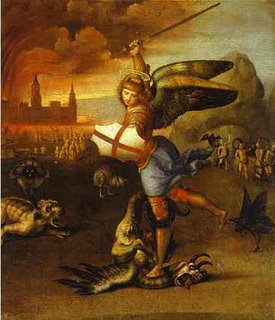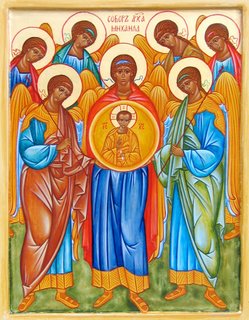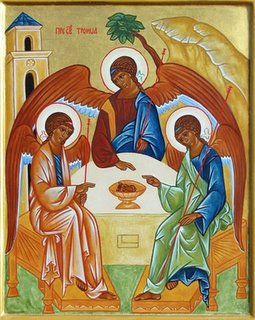On the Feast of Michael and all Angels, popularly called Michaelmas, we give thanks for the many ways in which God's loving care watches over us, both directly and indirectly, and we are reminded that the richness and variety of God's creation far exceeds our knowledge of it.
The Holy Scriptures often speak of created intelligences other than humans who worship God in heaven and act as His messengers and agents on earth. We are not told much about them, and it is not clear how much of what we are told is figurative. Jesus speaks of them as rejoicing over penitent sinners (Lk 15:10). Elsewhere, in a statement that has been variously understood (Mt 18:10), He warns against misleading a child, because their angels behold the face of God. (Acts 12:15 may refer to a related idea.)
In the Hebrew Scriptures, it is occasionally reported that someone saw a man who spoke to him with authority, and who he then realized was no mere man, but a messenger of God. Thus we have a belief in super-human rational created beings, either resembling men in appearance or taking human appearance when they are to communicate with us. They are referred to as "messengers of God," or simply as "messengers." The word for a messenger in Hebrew is malach, in Greek, angelos, from which we get our word "angel" [Digression: angelion means "message, news" and euangelion means "good news = goodspell = gospel," from which we get our word "evangelist" used to mean a preacher of the Good News of salvation, and, more narrowly, one of the four Gospel-writers: Matthew, Mark, Luke, and John.]
By the time of Christ, Jewish popular belief included many specifics about angels, with names for many of them. There were thought to be four archangels, named Michael, Gabriel, Raphael, and Uriel. An alternative tradition has seven archangels (see Tobit 12:15 and 1 Enoch 20). Sometimes each archangel is associated with one of the seven planets of the Ptolemaic system (the moon, Mercury, Venus, the Sun, Mars, Jupiter, Saturn). Michael is associated with Saturn and Uriel with the Sun. The other pairings I forget, but I believe that you will find a list in the long narrative poem called "The Golden Legend," by Henry Wadsworth Longfellow. (I believe that a pairing is also offered in the opening chapters of the Proof of the Apostolic Preaching, by Irenaeus of Lyons, but I have not the work at hand.)
 Michael (the name means "Who is like God?") is said to be the captain of the heavenly armies. He is mentioned in the Scriptures in Daniel 10:13,31; 12:1 (where he is said to be the prince of the people of Israel); in Jude 9 (where he is said to have disputed with the devil about the body of Moses); and in Revelation 12:7 (where he is said to have led the heavenly armies against those of the great dragon). He is generally pictured in full armor, carrying a lance, and with his foot on the neck of a dragon. (Pictures of the Martyr George are often similar, but only Michael has wings.)
Michael (the name means "Who is like God?") is said to be the captain of the heavenly armies. He is mentioned in the Scriptures in Daniel 10:13,31; 12:1 (where he is said to be the prince of the people of Israel); in Jude 9 (where he is said to have disputed with the devil about the body of Moses); and in Revelation 12:7 (where he is said to have led the heavenly armies against those of the great dragon). He is generally pictured in full armor, carrying a lance, and with his foot on the neck of a dragon. (Pictures of the Martyr George are often similar, but only Michael has wings.)
 Gabriel (the name means "God is my champion") is thought of as the special bearer of messages from God to men. He appears in Daniel 8:16; 9:21 as an explainer of some of Daniel's visions. According to the first chapter of Luke, he announced the forthcoming births of John the Baptist and of our Lord to Zachariah and the Virgin Mary respectively.
Gabriel (the name means "God is my champion") is thought of as the special bearer of messages from God to men. He appears in Daniel 8:16; 9:21 as an explainer of some of Daniel's visions. According to the first chapter of Luke, he announced the forthcoming births of John the Baptist and of our Lord to Zachariah and the Virgin Mary respectively.
 Raphael (the name means "God heals") is mentioned in the Apocrypha, in the book of Tobit, where, disguised as a man, he accompanies the young man Tobias on a quest, enables him to accomplish it, and gives him a remedy for the blindness of his aged father.
Raphael (the name means "God heals") is mentioned in the Apocrypha, in the book of Tobit, where, disguised as a man, he accompanies the young man Tobias on a quest, enables him to accomplish it, and gives him a remedy for the blindness of his aged father.
 Uriel (the name means "God is my light" -- compare with "Uriah", which means "the LORD is my light") is mentioned in 4 Esdras.
Uriel (the name means "God is my light" -- compare with "Uriah", which means "the LORD is my light") is mentioned in 4 Esdras.
It is thought by many scholars that the seven lamps of Revelation 4:5 are an image suggested by (among many other things) the idea of seven archangels.
What is the value to us of remembering the Holy Angels? Well, since they appear to excel us in both knowledge and power, they remind us that, even among created things, we humans are not the top of the heap. Since it is the common belief that demons are angels who have chosen to disobey God and to be His enemies rather than His willing servants, they remind us that the higher we are the lower we can fall. The greater our natural gifts and talents, the greater the damage if we turn them to bad ends. The more we have been given, the more will be expected of us. And, in the picture of God sending His angels to help and defend us, we are reminded that apparently God, instead of doing good things directly, often prefers to do them through His willing servants, enabling those who have received His love to show their love for one another.
Everything You Never Wanted to Know about Angels
The major post-New-Testament source for Christian ideas about angels is a writer (probably a fifth-century Syrian monk) who signed himself "Dionysius the Areopagite." His writings were taken to be those of a convert of the Apostle Paul, mentioned in Acts 17:34. Accordingly, when he wrote on angels (or any other theological subject), he was assumed to know what he was talking about. His writings had a considerable influence on the portrayal of angels in art and in the popular imagination.
What is a seraph?
Seraphim are mentioned in the Bible in Isaiah's vision of the heavenly throne-room (Is 6:1-7), where the LORD is seated between two seraphim. (In Hebrew, most masculine nouns form the plural by adding "-im".) Each has six wings, and with two he covers his face, and with two he covers his feet, and with two he flies. Later writers identify these functions with poverty, chastity, and obedience. Poverty, in that he veils his face, a sign of humility. Chastity, in that he covers his feet, a standard Hebrew idiom (or euphemism) for the lower body, including the crotch. Obedience, in that he flies to carry out whatever commission he receives from God. The word "seraph" comes from a root meaning "to burn", and the word is used in Nu 21:6,8; Dt 8:15; Is 14:29; 30:6; where it is translated "fiery serpent." Probably the Hebrews pictured a seraph as a kind of fiery winged serpent or reptile.
What is a Cherub?
Cherubim are first mentioned in the Bible in Gen 3:24, where Adam and Eve are expelled from the Garden, and two cherubim are set at the gate to guard it, so that no one may enter. The Psalmist says of God:
He rode upon a cherub, and did fly; he came flying on the wings of the wind. (18:10)
thou that dwellest between the cherubim (80:1)
he sitteth between the cherubim; let the earth quake (99:1)
From this we infer that they were pictured and thought of as winged creatures flanking or supporting the throne of God.
Ancient Middle Eastern art regularly shows the throne of a king or a god flanked by, or sometimes resting on, two creatures. Typically, each creature has the body of a lion or a bull (often the front quarters of a lion, with claws, and the hind quarters of a bull, with hooves, or vice versa), the head of a man, and the wings of an eagle. We see these creatures, not only flanking a throne, but also flanking the gate or doorway of a city or a temple. They appear to be standard figures, performing the function of honor guards or that of guard dogs.
In Ex 25f and 36f, the Israelites are to make a chest called the Ark of the Covenant, and place on the lid statues of two cherubim, with their wings arching over and meeting in the middle. Aside from the fact that they had wings, we are not told anything about their appearance. It was apparently taken for granted that the Israelites already knew what a cherub was supposed to look like. It is a reasonable guess that they looked like the guard figures already standard in Middle Eastern art, as noted above.
The Ark represented the presence of God, and presumably the Israelites thought of the cherubim as guarding or flanking or supporting an invisible throne. Thus, the Ark gave two complementary messages. On the one hand, it said, "The LORD cannot be represented by a picture or statue. He is spirit, He is invisible. He is transcendant. The whole universe cannot contain Him." On the other hand, it said, "Here is the place where the LORD chooses to reveal Himself. This is the place toward which you are to direct your homage, this is the focus of your worship."
The prophet Ezekiel records two visions (Ez 1 and 10) in which the LORD appears to him, enthroned above four figures identified as cherubs. Each is said to have four faces, one facing in each direction, the face of a man, a lion, a bull, and an eagle.





